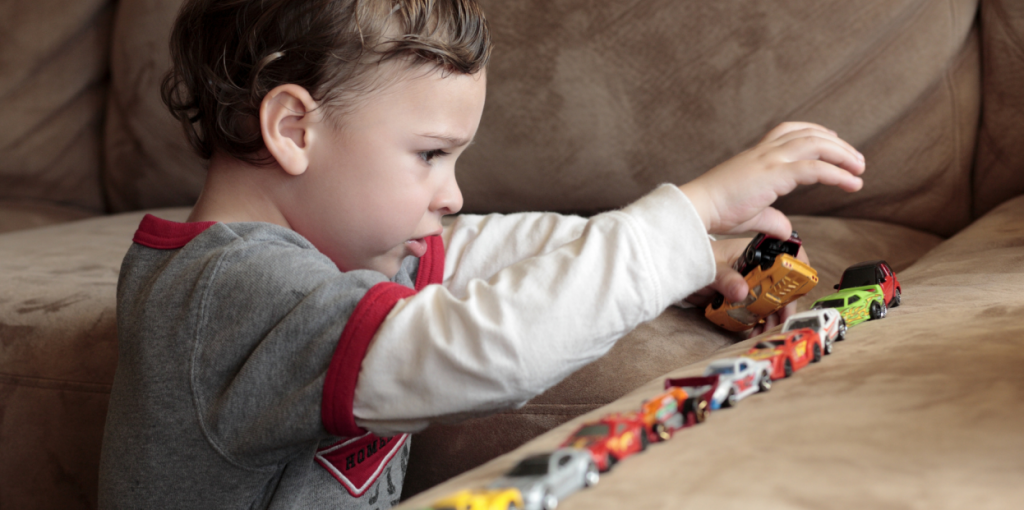
On the Spectrum: The Benefits of Play for Children with Autism and other Neurologically-Based Disorders
For a child with attention deficit hyperactivity disorder (ADHD) or autism spectrum disorder (ASD), regular daily activities can be fraught with anxiety or difficulty. As a parent, you might wonder how to best support your child. Today, numerous therapies, such as applied behavior analysis (ABA) and social skills groups, can boost your child’s development. At home, though, play is the way.
(Playful Bee is launching our new DIY Preschool from Birth program! Click here to enroll.)
Sensory Regulation
Most children with ASD or ADHD have some difficulties in sensory processing. These difficulties can manifest themselves as meltdowns, extreme over-excitement, or even avoidance of certain activities and experiences. Play is a vital part of managing sensory integration, notes Ellen Notbohm and Veronica Zysk, co-authors of 1001 Great Ideas for Teaching & Raising Children with Autism or Asperger’s. For most children, sensory integration should be the first issue to address. Improved sensory integration reduces behavioral issues and paves the way for true learning. Here are a few tips from Notbohm and Zysk to increase your child’s sensory experiences:
- Paint with pudding.
- Explore warm play dough.
- Fill a bucket with rice or sand, bury toys in it, and let your toddler find the toys.
- Blow bubbles.
- Explore an appliance box.
- Put chamomile or lavender tea bags in the bathtub to create a lovely fragrance.
Healthy Brain and Motor Development
Researchers at Baylor College of Medicine found that children who don’t play much or rarely receive touch from their parents develop brains 20 to 30 percent smaller than normal, which reveals the impact that a lack of stimulation has on a developing brain. “The body and mind are codependent, and the brain’s only continuous source of stimulation comes from the body’s resistance to gravity, which happens through movement,” according to Dr. Robert Melillo, an internationally renowned expert in neurobiological disorders and author of Disconnected Kids.
Dr. Melillo believes that children with ADHD and ASD disorders have a right brain deficit. Motor activities can help balance the right and left brain, reducing many of the symptoms associated with neurologically-based problems. Read on to learn his tips for healthy motor and brain development.
- Limit television, computer games, and video games to no more than one hour per day.
- Get outdoors for at least an hour every day. More is even better.
- Go for walks, jump on a trampoline, or roll down a hill. You may have to “motor” your child through these activities initially. That’s okay. Eventually muscle memory will kick in.
- Sign up for parent-child tumbling classes or take swimming lessons together.
- Install a swing. Many children with ASD love to spin and swing. These activities are soothing and stabilizing.
All children need regular, active play, but children with ASD and ADHD can especially benefit from it. Priscilla Leto, mother of a child with autism, says, “When Matthew was a toddler, he would spend all day watching TV and playing Nintendo while I worked from home. Once I started restricting TV time and taking him outside and to the park on a daily basis, I immediately started seeing changes.”
Communication and Reciprocity
“Many children with the diagnosis of autism spectrum have sensitivities in their sensory systems and experience problems in managing their levels of excitement (regulation) that render them less available for human engagement,” notes Dr. Gerard Costa, the Director for the Center for Autism and Early Childhood Mental Health at Montclair State University. “In particular, these children may have difficulty in relationships which rely on much language and eye contact.”
Dr. Costa says that children with ASD are interested in relationships and are attached to their parents, but their neurobiology may make it more difficult to show this attachment. Playful interactions can help these children learn the communication and social skills they need to thrive. Below are a few tips for playful language and communication:
- Play games that require reciprocity, such as Peek-a-Boo or Pat-a-Cake.
- Use exaggerated facial expressions and gestures.
- Play musical instruments together: beat a drum, shake a tambourine, etc.
- Attend story hours that incorporate music and drama. Some libraries now offer sensory-friendly story times.
- Use fewer words and allow a longer response time.
- Read simple board books. Read with animation and emotion.
Play can be a wonderful vehicle for healthy development. “Be sure to encourage play with people, using objects, meaning that the toy or object simply provides the material for the social relationship,” says Dr. Costa. “Rather than having a child complete a puzzle or stack blocks by themselves, take turns, make faces, and be sure you are more interesting than the objects.”
(Playful Bee is launching our new DIY Preschool from Birth program! Click here to enroll.)
For more information:
Autism Speaks. Applied Behavior Analysis (ABA). Autism Speaks. Retrieved April 22, 2013, from http://www.autismspeaks.org/what-autism/treatment/applied-behavior-analysis-aba.
Ellen Notbohm (2013). Ellen Notbohm: Award-Winning Author and Columnist. Retrieved Aprill 22, 2013, from http://www.ellennotbohm.com/.
Autism Today. Experts Bio: Veronica Zysk — Autism Author and Columnist. Autism Today. Retrieved April 22, 2013 from http://www.autismtoday.com/experts/experts_bio.asp?exp_id=75&name=Veronica%20Zysk&lname=Zysk.
Dr. Robert Melillo. Brain Balance Achievement Centers. Retrieved April 22, 2013, from http://www.brainbalancecenters.com/about/the-team/dr-robert-melillo/.
Center for Autism and Early Childhood Mental Health. Montclair State University: The College of Education and Human Services. Retrieved April 22, 2013, from http://www.montclair.edu/cehs/academics/centers-and-institutes/autism/.
Julie Christensen
Latest posts by Julie Christensen (see all)
- From Babbling to First Words: The Adventure of Language Development - August 28, 2017
- Your Little Linguist: Play’s Role in Language Development - June 26, 2017
- Play Gets the Body Moving: Play and Motor Skills - April 5, 2017

+ There are no comments
Add yours